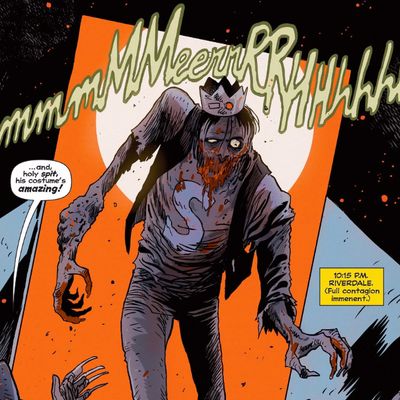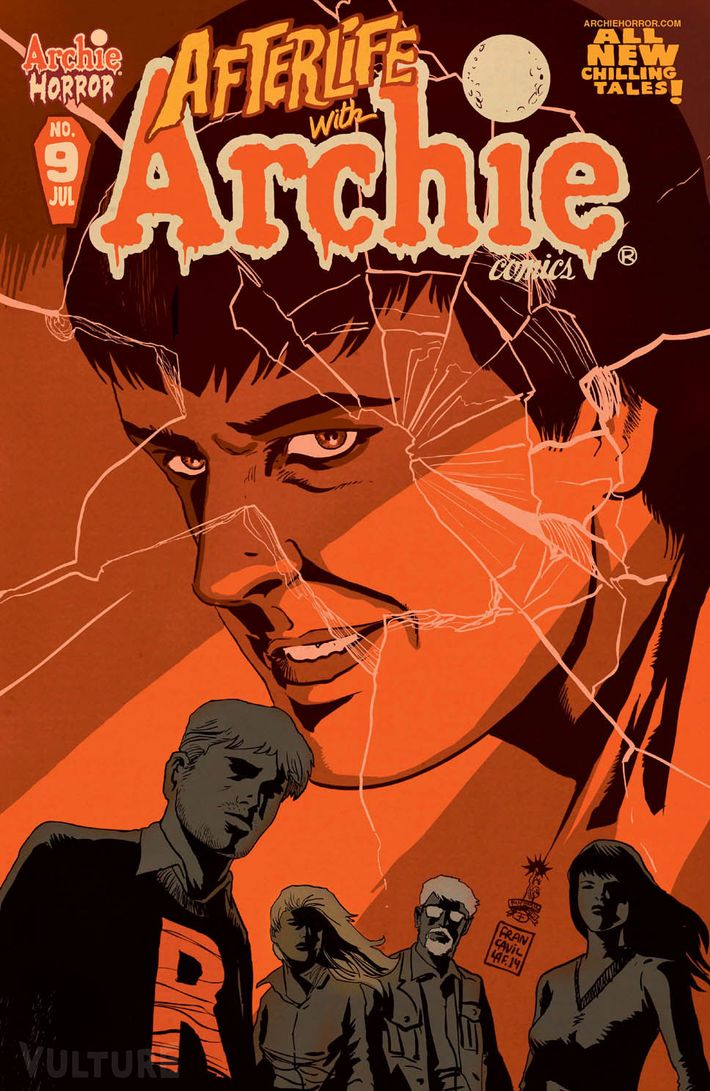
A few years ago, Mitch Cutler was an evangelist about Afterlife With Archie. He works at St. Mark’s Comics in downtown Manhattan and had prided himself on telling people to buy this strange-but-gripping ongoing Archie Comics series that envisioned a zombie apocalypse coming to the idyllic town of Riverdale and turning Archie into a hardened monster-hunter. He says customers would hear about the comic’s existence online or from friends and ask him about it, and Cutler would bowl them over with a spirited endorsement.
“They’re expecting us to say, ‘It’s terrible,’” he says. “And instead we’d say, ‘It’s awesome, and you should read it. It’s really good.’ And then that’s what builds it.” But, like many evangelists, he’s had a crisis of faith. The first six issues came out at a relatively standard pace: A new installment would get published every six to eight weeks. Then, out of nowhere, there was a 20-week gap between issues six and seven. Then there was a 21-week gap before issue eight. And then … the series just stopped. For months, there was no word about when issue nine would come out. Archie announced in February that it would come out on May 25 — and although Cutler suspects the content “will still be wonderful,” he’s worried about all the lost momentum.
“We will have to do a great deal of work to remind people that they liked it,” he says. That kind of work, done by comic-shop employees like Cutler, is what can make or break a series like Afterlife. We live in an age when most Americans get music, TV, books, and movies from chain stores and online outlets. But the comics industry, with its backbone of mom-and-pop, brick-and-mortar retailers, is a unique and charmingly archaic throwback — and the anatomy of what happened with Afterlife With Archie and the delays’ impact on the publisher and retailers paints a picture of a market unlike any other in entertainment.
There are no nationwide comic-book chain stores, and there’s a relatively tiny audience — the top-selling comic of March, Batman No. 50, only shipped an estimated 163,406 copies to retailers. Digital releases of comics on sites like comiXology.com have been growing in recent years, but they’re comparatively small — it’s estimated that digital sales only account for about 20 percent of the comics market. So if the comics medium doesn’t have equivalents of behemoths like Amazon or Spotify providing access to product, the fewer than 3,000 individual stores in the country end up being crucial in determining whether a given series lives or dies, especially if it doesn’t star a hugely popular character like Spider-Man or Superman.
“We’re like bartenders or sherpas,” says industry analyst Brian Hibbs, who has owned and operated San Francisco’s Comix Experience store since 1989. “If the staff likes a book and promotes it, those are the books that sell the best. That’s not true in any other kind of media.” He, like Cutler, was a big pusher of Afterlife With Archie, but he’s worried about its return. “As a retailer, I’m unlikely to put my imprimatur on it again,” he says. “While I think Afterlife With Archie will continue to sell better than any other Archie comic, I don’t think it’ll return to the heights it reached.”
But for a time it was soaring. According to Archie CEO Jon Goldwater, it began as the “visual brainchild” of artist Francesco Francavilla. In October 2012, Francavilla published a so-called “variant cover” — an alternate cover for a comic book that’s sold in special circumstances or given to a retailer if they order a certain number of copies — for Life With Archie No. 23. The image was a one-off gag, depicting the titular teenager under attack from zombified versions of his pals. He rewrote the title to read “Afterlife With Archie.”
“It was a thing of beauty,” Goldwater says. He recalls having breakfast with his son Jesse and screenwriter, playwright, and comics scribe Roberto Aguirre-Sacasa a few days after the cover came out. “Roberto, who is also a student of all things horror and an amazing writer, was telling Jesse how disappointed he was that the cover wasn’t representative of what was inside,” Goldwater remembers, and the discussion turned to the idea of making an actual comic featuring the concept. “I green-lit it right there,” he says. “But the only person who could draw it was Francesco.”
Francavilla and Aguirre-Sacasa linked up and were off to the races. The first issue debuted on October 9, 2013. It was an instant hit. Retailers demanded so many copies of that first issue that Archie had to reprint it five times, leading to an eventual total of 54,270 copies ordered by retailers (there are no industry-wide statistics for final sales, only the representative indicator of retailer orders). The second issue came out the next month and had four printings. Sales were strong for the next few, too, usually clocking in between 25,000 and 27,000 copies ordered (there are almost always big drop-offs in sales after a first issue, but these numbers were strong for an indie book). People were eating the series up.
However, storm clouds formed in 2014 and 2015. The creators were having trouble making deadlines because they were overloaded with other work: Francavilla was doing artwork for other publishers, and Aguirre-Sacasa had become Archie’s chief creative officer, on top of writing an Archie TV pilot called Riverdale and the book for Broadway’s American Psycho musical adaptation. “There was never a moment where the red phone rang and we realized things were off the rails,” Goldwater recalls. “It was a gradual acceptance that the book was going to be late.”
Goldwater says it was never his intention for Afterlife to come out every month — he envisioned it as hitting stores every six to eight weeks. But the gaps started to be much wider than that. Issue No. 6 came out on July 23, 2014. No. 7 didn’t arrive until December 10 of that year, and No. 8 was released nearly a half-year later, on May 6 of 2015. Then there was silence. Archie didn’t send out a planned release date for No. 9. Retailers weren’t pleased.

“We promote these books and say they’ll be out a certain day, and now we have to change our whole routine,” says Andrew Cohen, marketing manager for New York superstore Midtown Comics. “It’s tough to inform fans, ‘Sorry, this book’s not gonna be out next week. You gotta wait until who-knows-when.’”
Delays on a popular comic don’t leave store owners in the red, per se — if a given issue doesn’t have a release date, the owners don’t prepay for it. In those cases when a comic does have a release date and stores place orders and then there’s a delay, publishers will usually let retailers return the issues to recoup their losses.
The problem with Afterlife With Archie was lost potential revenue. As Hibbs suggested, people lose interest in a chronically delayed comic, typically buying fewer copies when it comes back. “Where we were selling 45 copies, when it comes back, I think we’re gonna sell 25 copies,” says Hibbs of Afterlife With Archie’s upcoming return. “That’s 20 sales that we don’t have anymore. And there should’ve been about six issues out over the time they haven’t been out, 120 books that I could’ve sold.”
This kind of fear often leads retailers to drastically cut their orders for delayed comics. In the 2000s Marvel Comics put out a mini-series penned by film writer and director Kevin Smith called Spider-Man/Black Cat, which ran into delays of more than three years between issues three and four as a result of Smith missing his deadlines. Retailers ordered an estimated 105,800 copies of the former, and only 57,089 of the latter.
A giant comics company like Marvel or DC has a more diversified portfolio, meaning any one late title doesn’t hurt as much. Archie, on the other hand, hovers around 16th place in market share, currently publishing 16 monthly titles, whereas Marvel publishes about 80. For a company of that size, every sale counts — and they don’t have the clout to bully a retailer in the way a heavyweight like Marvel can.
As the delays on Afterlife continued and Archie Comics feared a sales collapse, it had to consider emergency measures. Goldwater had an option that delayed comics have taken in the past: Just swap out one or both of the lead creators. Such swaps have happened in high-profile series of recent years like Marvel’s New X-Men and DC’s Final Crisis, and fans are never pleased. But Goldwater says he ruled that out, because Aguirre-Sacasa and Francavilla were integral to the series’ appeal. He also says Archie made efforts to reach out to retailers and the industry’s main distributor, Diamond, to say Afterlife was coming eventually: “While it’s not always perfect news — no one likes to hear ‘it’s coming’ or ‘we’re working on getting the next issue out the door’ — it’s not disingenuous or false,” he says.
Ultimately, Goldwater took the approach of “riding it out, to a degree” — he kept in communication with Aguirre-Sacasa and Francavilla and waited for them to say they could finish more issues. By the beginning of this year, Archie felt the creators had done enough to announce that the series would be back in May. Goldwater cites the completion of the Riverdale pilot as a key accomplishment that allowed Aguirre-Sacasa to have more time, and Francavilla’s schedule cleared up a bit, too. “I feel like we’re rolling along in a way that eluded us last year because of many factors outside of our control,” Goldwater says.
Now the challenge for Archie is to get back on track with sales. There are definitely success stories for delayed comics — in the past decade, series like Image’s Jupiter’s Legacy (a ten-month gap between issues four and five) and DC’s Planetary (a three-year gap between issues 26 and 27) saw only small or nonexistent dips in retailer orders after long stretches without new issues. The key for those was building anticipation for the comics’ resurrections: Publishers would hype the return issue as an event that would finally satisfy pent-up demand.
Archie has been trying to capitalize on that fondness in its marketing for Afterlife No. 9: An ad for the issue and another delayed Archie series, Chilling Adventures of Sabrina, has a headline reading, “THE HORROR RETURNS,” and the solicitation text says that “after much anticipation” the comics are coming “back from the brink.” Although the comic has been out for a day, it still has another hurdle to climb: It needs to hold on to valuable shelf space. The physical constraints of a brick-and-mortar retailer mean you can only put a limited number of comics in prime visual spots for shoppers. Employees will have to decide how confident they are that Afterlife will sell — and if it doesn’t sell well in the first week, it might get shuffled away from the line of sight of a browser.
That said, not all retailers are worried about Afterlife. “You can consider me optimistic,” says Jeff Ayers, manager of Manhattan’s Forbidden Planet. He notes that delays are so much more common in comics than they are in movies, music, or TV — which means readers are a little more tolerant when their favorites disappear for a bit: “The story line is great in and of itself, and it can sustain a delay.” Hibbs, for his part, is adopting a wait-and-see attitude. “There’s a point where you cross a line where you can’t come back from,” he says, before adding with a laugh, “But this is a book about the undead, so who knows?”

